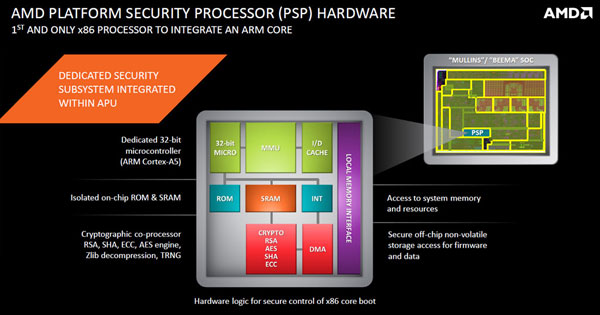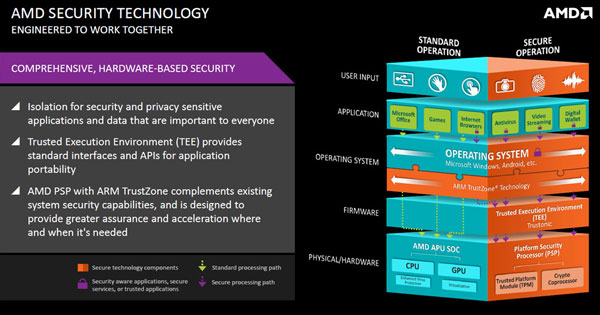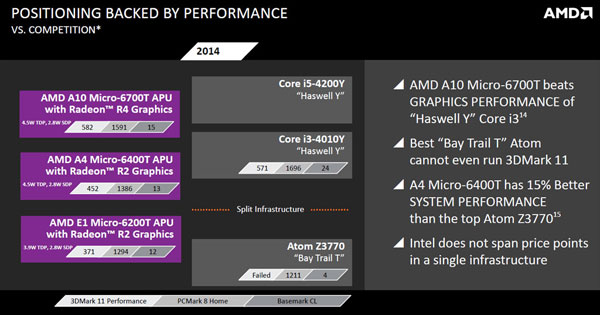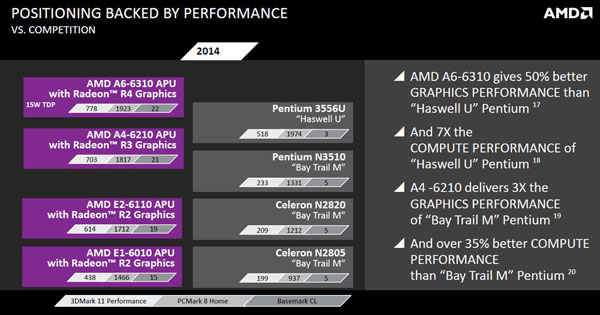Mullins And Beema APUs: AMD Gets Serious About Tablet SoCs
AMD recently introduced us to its Mullins and Beema APUs, which are architecturally similar to Kabini and Temash, but include some power and performance enhancements. We take an early look at a custom form factor and compare to Intel's best effort.
The Platform Security Processor, APU Models, And Market Positioning
AMD's updated low-power APUs are the first (and so far, only) x86 processors with an integrated ARM core. Dubbed the Platform Security Processor (PSP), this core is actually a 32-bit ARM Cortex-A5 with its own ROM and SRAM. The PSP is designed to provide a secure processing path, a trusted execution environment (TEE), a Trusted Platform Module (TPM), and a crypto co-processor capable of operating within ARM's TrustZone blanket of hardware-enabled security services.
At least on paper, the Platform Security Processor is an interesting IP add-on that we'd imagine stems from a desire to make mobile devices in the workplace easier to manage and control, since these aren't capabilities most home users want or need. AMD appears to be courting a segment currently under-serviced by existing ARM-based SoCs and Intel's own Bay Trail devices. However, it remains to be seen whether ISVs develop around the on-die hardware to expose its capabilities in software.
Models And Market Positioning
By now it's pretty clear what we're dealing with at the heart of AMD's newest mobile APUs. The following chart spells out how AMD is segmenting its Mullins-based models:
| Header Cell - Column 0 | Radeon Brand | SDP | TDP | CPU Cores | Max CPU Clock | L2 Cache | Shaders | Max GPU Clock | Memory |
|---|---|---|---|---|---|---|---|---|---|
| A10 Micro-6700T | R6 | 2.8 W | 4.5 W | 4 | 2.2 GHz | 2 MB | 128 | 500 MHz | DDR3L-1333 |
| A4 Micro-6400T | R3 | 2.8 W | 4.5 W | 4 | 1.6 GHz | 2 MB | 128 | 350 MHz | DDR3L-1333 |
| E1 Micro-6200T | R2 | 2.8 W | 3.95 W | 2 | 1.4 GHz | 1 MB | 128 | 300 MHz | DDR3L-1066 |
The TDP range is tight, hanging between 3.95 and 4.5 W. Further, AMD attaches an SDP rating of 2.8 W up and down the line-up, conveying the power use expected during normal activity. Both top-end versions are quad-core configurations, receiving A10 and A4 branding, but differentiated by the addition of Micro as a prefix to their model number. The lone dual-core SoC bears the E1 designation.
AMD takes a different tact with its graphics marketing, using R2, R3, and R6 to indicate performance at multiple clock rates, since all three options sport 128 shaders.
Clearly, AMD hopes that Mullins will compete against Bay Trail-T and the more powerful Haswell-Y processors. And although there aren't any products with AMD's hardware inside yet, we're going to be benchmarking the potential of A10 Micro-6700T in a passively-cooled reference-class tablet.
| Header Cell - Column 0 | Radeon Brand | TDP | CPU Cores | Max CPU Clock | L2 Cache | Shaders | Max GPU Clock | Memory |
|---|---|---|---|---|---|---|---|---|
| A6-6310 | R4 | 15 W | 4 | 2.4 GHz | 2 MB | 128 | 800 MHz | DDR3L-1866 |
| A4-6210 | R3 | 15 W | 4 | 1.8 GHz | 2 MB | 128 | 600 MHz | DDR3L-1600 |
| E2-6110 | R2 | 15 W | 4 | 1.5 GHz | 2 MB | 128 | 500 MHz | DDR3L-1600 |
| E1-6010 | R2 | 10 W | 2 | 1.35 GHz | 1 MB | 128 | 350 MHz | DDR3L-1333 |
The Beema-based parts have TDPs between 10 and 15 W. There aren't any SDP ratings; that's because SDP is reserved for devices designed with a touch-first usage model in mind, and those aren't what Beema will drop into.
Get Tom's Hardware's best news and in-depth reviews, straight to your inbox.
Again, most of the SoCs are quad-core configurations; just one, the E1-6010, is a dual-core SoC. As with the Mullins-based parts, branding of the Radeon engine depends on clock rate, since every model includes 128 shader cores.
AMD plans to pit Beema against Bay Trail-M and Haswell-U in low-power laptops. True performance comparisons will need to wait until the company is able to secure design wins. But nothing about the specs suggest the theoretical match-up is unbalanced.
What we do have to test is an A10 Micro-6700T-equipped reference tablet that AMD calls its Discovery tablet, which we'll look at on the next page.
Current page: The Platform Security Processor, APU Models, And Market Positioning
Prev Page Meet The Mullins And Beema Tablet APUs Next Page The Discovery PlatformDon Woligroski was a former senior hardware editor for Tom's Hardware. He has covered a wide range of PC hardware topics, including CPUs, GPUs, system building, and emerging technologies.
-
Nintendo Maniac 64 ...yeah, I don't think intending to benchmark full-on PC games that aren't even a year old on what is essentially a tablet APU was one of the wisest decisions you guys have made.Reply -
cleeve Reply13193339 said:...yeah, I don't think intending to benchmark full-on PC games that aren't even a year old on what is essentially a tablet APU was one of the wisest decisions you guys have made.
Actually, both Dota2 and Grid2 are well known for having low system requirements, and they represented a great opportunity to compare results to the desktop bay trail and kabini platforms. We would have tested these games regardless, but we would have added more, less demanding titles if we had more time.
-
Nintendo Maniac 64 Hmmm, sounds like an AMD equivalent of an Intel "tick", especially considering that the IPC between Puma+ and Jaguar is unchanged.Reply
Interestingly enough, this would mean that the PS4 and Xbone could use Puma+ cores in the future (with turbo disabled obviously).
-
PreferLinux OK, so where are the power measurements? That is about the most important part of the chip, and is also the part that is missing.Reply -
kyuuketsuki I'm not sure why you decided to benchmark Dota at 1920x1080 instead of 1200x800. You lost the ability to compare against the Venue 8 Pro *and* the results might have been something resembling playable. I'm always of the opinion that game benchmarking should focus around what the product in question (and its competitors) can actually, y'know, play. Seeing graphs of everything being in a range of 1-10 FPS just isn't interesting or particularly useful.Reply
But yeah, I understand the limited time and environment, and the look at Beema and Mullins is greatly appreciated. I'm *still* looking forward to a commercially-available tablet with an AMD SoC in it, since one never materialized with Temash. That Vizio tablet that used AMD was actually pretty nifty, except for using the Z-60(?) which just wasn't up to scratch. It's too bad Vizio seems to be deprecating its tablet efforts, since an update of that tablet with Mullins in it would be worth looking at. -
NoClue_87 Dota2 is very cpu intensive. It's a shame Valve aint interested in suporting mantle for dota 2.Reply -
CaptainTom I seriously cannot wait when 5 years from now I can get mid-range PC gaming in a tablet... The future cannot come soon enough...Reply -
tigger888 HOW is the author of this article NOT amazed that the apu is pushing NEAR 30 frames per second! With the competition only having half... Who pays these guys to write articles..Reply -
de5_Roy looks quite promising. these socs will be in media consumption devices, so i hope you'll include various media playback benches in the review.Reply
the tskin temp and tjmax temp look a bit low for outside use. i wonder if it'll be enough to prevent throttling in actual devices. -
cleeve Reply13193593 said:HOW is the author of this article NOT amazed that the apu is pushing NEAR 30 frames per second! With the competition only having half... Who pays these guys to write articles..
How did you not read the commentary, yet decide comment on it?
The article is very complimentary to the new APU's game performance. What exactly did you expect? Did you want me to write that its the "SUPERBEST GAMING APU EVAR"?



